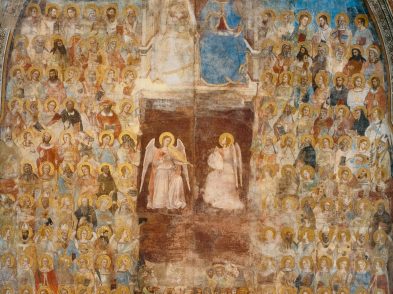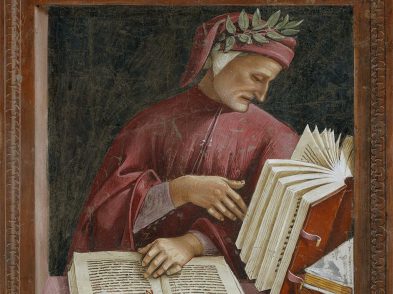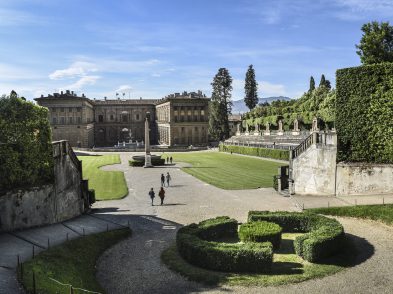Rumor has it that
Piero della Francesca’s Early Renaissance masterpiece The Duke and Duchess
of Urbino languished in the Uffizi’s deposits until the 1860s, when the
artist was ‘rediscovered’ by Cezanne. Thanks to the renewed attention, the
fifteenth-century della Francesca piece quickly became a must-see for visitors and
the unmistakable profiles are still one of the museum’s most popular stops. The
story may or may not be true, but it does serve to illustrate how artists are
often subjected to the fickle whims of critics and historians. Even Caravaggio
was essentially forgotten until the twentieth century when he was assigned the
label of one of history’s greatest and most influential painters.
It seems that
another ‘forgotten’ master is about to re-emerge onto the contemporary
criticism scene, this time thanks to a new restoration project funded by
Friends of Florence. The artist is a little-studied artist known simply as the
Master of Figline. His pseudonym references a large-scale Virgin and Child
with Saints and Angels in the Collegiata at Figline Valdarno, just south of
Florence. Information on the artist is so scant that scholars disagree over his
origins some say Roman or Umbrian while others say Florentine and the exact
dates of his activity, though it appears he was active in Assisi and Florence
from c. 1310 to c. 1330. If the dates and the towns sound familiar, it is
likely because they coincide with Italy’s medieval artist par excellence,
Giotto. In fact, the Master of Figline is considered a protogiottesco (follower of Giotto) and the artists are thought to have worked
contemporaneously both in Santa Croce and in the Basilica di San Francesco in
Assisi. Given the master’s work in two of the most renowned Franciscan
basilicas, some have argued that he may have been a brother in the order.
The Friends of
Florence are restoring one of the most important works attributed to the Master
of Figline: the large wooden crucifix over the main altar in Santa Croce. In
keeping with the artist’s enigmatic past, the exact details of the commission
for the crucifix are not known. However, it is believed that it was completed
between 1317 and 1325 at the request of the Franciscans. Though we know it was
commissioned for the basilica, the work was moved to various locations
throughout the centuries, and it was definitely housed in the sacristy until
1933 when it was hung over the main altar.
Last restored in
1957 for an exhibition on Giotto, the crucifix’s surface was darkened with dirt
and the area below Christ’s feet was black from candle burns. Cracks in the
supports and junctions were evident. The Opera di Santa Croce presented the
project to Simonetta Brandolini d’Adda and the Friends of Florence, who were
fascinated with the idea of an ‘open’ restoration one that takes place on
site and in full view for visitors. According to Brandolini d’Adda, the cross
has a special significance for donors Virginia and Serafino Iacono who were
immediately taken with the project. So taken, in fact, that they encouraged
their friends Colleen De Bonis and Neil Woodyer to become donors as well. The
two couples and their families have been to Florence several times to visit the restoration site and
see the progress first-hand.
Restoration expert
Muriel Vervat heads up the team completing the unique three-part project. The
first part is to restore the entire crucifix, including the wood itself as well
as the painting. Once restored, the work will be placed on a steel structure
designed specifically to bear the cross’ weight and allowing it to be raised
and lowered for future cleaning and restoration. The third part of the project
is where the rediscovery truly takes place. In an effort to foster exchange and
scholarly research, several prestigious entities including Harvard University
Art Museums, the Opificio delle Pietre Dure, the Sopraintendenza per i Beni
Culturali and the Courtauld Institute of Art plan to establish an open-source
tool to aid collaboration between international partners sharing technical,
archival and historical information about the Master of Figline.
‘When we took the
crucifix down and began the preliminary studies it was immediately clear that
this was a work by a very refined and unique artist,’ explained Vervat. ‘His
sophistication is evident, for example, in the use of red lacquer to outline
Saint John’s teeth and render his pain extraordinarily palpable.’ According to
Vervat, the painting was incredibly well-preserved so much so that even the
preparatory drawings were visible when viewed with infrared technology. The
same technology also enabled restorers to determine that the master used the
highest quality materials in the execution of the painting, including lapis
lazuli, a native Afghan pigment so precious that it cost five times the amount
of gold. It turns out that his technique was as precise as his choice of
materials: ‘The Madonna’s sorrowful gaze is highly advanced for a painter of
the early fourteenth century; we don’t typically see this type of pathos until
much later on.’
As with many
remarkable works of art, however, it is more than just technique and color that
make this piece memorable. Vervat points to the ‘intensity of feeling’ in
Christ’s face as a prime reason that this crucifix deserves more than just a
passing glance. Beyond restoration and preservation, the project emphasizes the
importance of a significant artist still relatively ‘undiscovered’ by modern
scholars. You heard it here first.
A book on the Master
of Figline crucifix will be published when the restoration is complete at the
end of 2010. For more information on the Friends of Florence, see www.friendsofflorence.org








